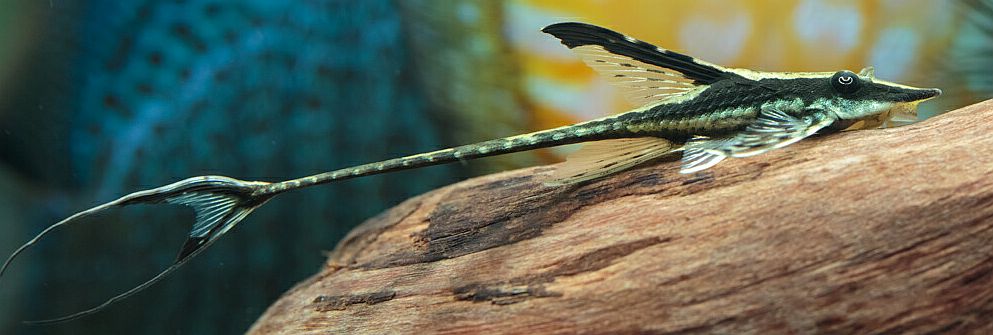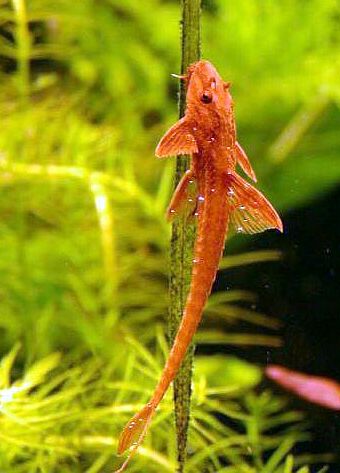The Whiptail Catfish (Rineloricaria) is popular with tropical fish keeping enthusiasts, and is one of the most peaceful catfish available for populating community tanks. Currently, there are 63 recognized species in this genus which makes it the most populated of the Loricariinae family.
The Whiptail Catfish is native to the rivers and lakes of northern and central South America and is usually found around leaf littered, sandy bottoms, in clear water and in water with a lot of dissolved sediment.
Rineloricaria lanceolata is widely distributed on nearly the entire subcontinent from Costa Rica to Argentina, and on both slopes of the Andes.
The Rineloricaria species are found in a variety of habitats that includes large rivers, streams, and lagoons with sandy or rocky bottoms. They are sometimes found in marginal vegetation and can tolerate a wide temperature range in their environment. Rineloricaria are extremely adaptive and have been collected in highly polluted bodies of water.
All Whiptail Catfish are members of the armored catfish family and have long, slender, brown and black colored bodies with elongated noses and a narrow face. They have a sucker mouth with no visible barbels for feeding on algae and other plant matter that they scrounge from sandy bottoms. They have an erect dorsal fin and a very thin caudal peduncle. The average length of adult Rineloricaria catfish is about 5″ long and they are relatively long lived (8 to 12 years).
By nature, the Whiptail is a social catfish that enjoys living in small groups and prefer the subdued lighting of their natural jungle environment.
Whiptail Catfish are an active species that can be housed with many other peaceful species in a natural community tank environment. They make a wonderful addition to any peaceful, freshwater community aquarium and get along well with Apistogramma, Corydoras, small Characins, other Loricariids, and many other non-aggressive species that will not out compete them for food.
Rineloricaria lanceolata is one of the most common of the species sold as “Whiptail Catfish” and are a great choice for introducing new tropical fish keeping enthusiasts to catfish breeding.
The Whiptail Catfish should be given a “biotope” setup with a sandy bottom and a layer of Oak, Beech or other type of non-toxic dried leaves spread over the bottom of the tank. Provide them with some smooth river rock, bogwood roots, artificial caves or pieces of PVC pipe for them to hide and spawn in.
Whiptail Cats also do well in a densely planted sandy bottom tank with driftwood and caves for them to hide in. They become retiring with bright lighting and should be provided plenty of shade plants and cover. They do well in well filtered water at temperatures of 77-82°F, a pH of 6.0-8.0, and a water hardness of 5-20°H.
When they are well fed and kept in suitable water conditions, the Whiptail Cat is easily bred. To identify a pair, place a small group of 6 or more juveniles together in a tank as described above with several lengths of 1 1/2″ PVC pipe to act as spawning caves. The water in the breeding tank should be soft and slightly acidic. The breeding pair should be conditioned on a diet of fresh spinach, kale, or other greenery and some live or frozen bloodworms. If no pairs show any sign of spawning, conduct a 50%-70% water change with cooler water every few days to simulate the rainy season that they encounter in their natural habitat.
When the pair is ready to spawn, the male will carefully choose and clean a “cave” where the eggs will be deposited. When the eggs are deposited and fertilized by the male, the female takes no farther responsibility for their care. The male guards the eggs from intruders and fans them until they hatch. You should remove all other fish from the breeding tank or remove the PVC pipe that the eggs were laid in to a nursery tank with the same tank water.
When the fry hatch in 4 or 5 days and are free swimming 2 to 3 days later, remove the male from the tank and start feeding the fry water soaked spinach or kale, fresh slices of cucumber, and baby brine shrimp. The fry starve easily and should always have access to pre-softened vegetable matter or algae covered rocks for them to graze on. The delicate fry are also sensitive to water quality and should be given daily partial water changes until they are large enough to be transferred to a larger community tank.
Feeding adult Whiptail Catfish is not difficult. The are not picky eaters and will get most of their nutrition from left over food and algae at the bottom of the tank. Their diet should be supplemented with sinking herbivore pellets, freeze dried or frozen bloodworms, spinach or a high quality flake food.




One Response to “Tropical Fish Keeping – Whiptail Catfish (Rineloricaria) a.k.a. Twig Catfish”
Trackbacks/Pingbacks
[…] to the article on Whiptail Catfish for additional information on breeding the Farlowella […]